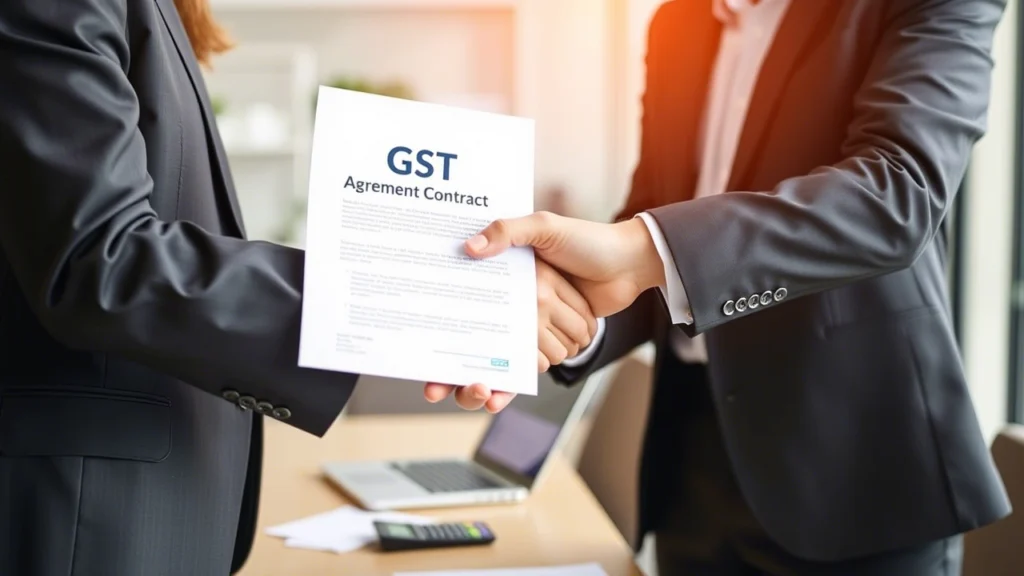
In this article we will discuss on how to add GST to an invoice in India, also understand who pays GST, how rates are decided, and billing processes. Step-by-step guide, FAQs, and expert tips for 2025!
Introduction to GST and Invoicing
GST (Goods and Services Tax) is a unified tax system in India that replaced multiple indirect taxes. Whether you’re a business owner, freelancer, or consumer, understanding how to add GST to an invoice is crucial. This guide explains everything in simple terms, including recent updates for 2025.
How is GST Decided?
GST rates in India are decided by the GST Council, a governing body with representatives from the central and state governments. The Council categorizes goods and services into four primary tax slabs: 5%, 12%, 18%, and 28%, based on their necessity and nature. For example, essential items like food grains, medicines, and educational tools fall under the 5% slab, while luxury goods like high-end cars or aerated drinks attract 28%. Certain items, such as healthcare services, fresh fruits, and education, are fully exempt from GST.
Businesses use HSN (Harmonized System of Nomenclature) codes for goods or SAC (Services Accounting Code) for services to identify the correct GST rate. For instance, laptops (HSN 8471) have an 18% GST rate. The Council revises rates annually to align with economic needs—in 2025, eco-friendly products like solar panels saw reduced rates to promote sustainability. Small businesses with turnover below ₹40 lakh (₹20 lakh for northeastern states) are exempt from charging GST. Always verify rates using the GST portal’s “Rate Finder” tool or the latest Council notifications to avoid errors.
GST Rates and Categories
GST rates in India are divided into four slabs: 5%, 12%, 18%, and 28%. Essential items like groceries fall under 5%, while luxury goods like cars attract 28%. Some items, like healthcare and education, are exempt from GST.
Example:
- 5% GST: Milk, bread, and books.
- 18% GST: Smartphones, furniture.
- 28% GST: Luxury cars, aerated drinks.
Table: GST Slabs in 2025
| Category | GST Rate | Examples |
|---|---|---|
| Essential Goods | 5% | Rice, medicines |
| Standard Goods | 12% | Processed foods |
| General Services | 18% | IT services, restaurants |
| Luxury Items | 28% | SUVs, premium cosmetics |
How to Determine Applicable GST
- Identify the product/service category.
- Check the Latest GST Rate Changes 2025
- Verify exemptions (e.g., small businesses below ₹40 lakh turnover).
Pro Tip: Use the GST Rate Finder Tool (updated for 2025) to avoid errors.
Who Pays GST on an Invoice?

The seller is legally responsible to charge and collect GST from the buyer on taxable supplies. However, the buyer ultimately bears the cost of GST, as it’s added to the invoice total. For instance, if a seller issues an invoice for ₹10,000 + 18% GST (₹1,800), the buyer pays ₹11,800.
Registered businesses (with GSTIN) can claim Input Tax Credit (ITC) to offset the GST they paid against their tax liability. For example, a manufacturer paying ₹5,000 GST on raw materials can deduct this amount from the GST they collect on finished goods.
Exceptions:
- Unregistered buyers cannot claim ITC and bear the full GST cost.
- Under the reverse charge mechanism (RCM), the buyer pays GST directly to the government, not the seller. This applies to specific services like legal consultations.
Note: While the seller collects GST, compliance falls on both parties. Buyers must verify invoices for GSTIN and correct rates to avoid mismatches in ITC claims.
Seller’s Responsibility
The seller must:
- Charge GST on taxable supplies.
- Display GSTIN (GST Identification Number) on invoices.
- File regular GST returns.
Buyer’s Liability
The buyer must:
- Pay GST included in the invoice.
- Claim Input Tax Credit (ITC) if registered under GST.
Example: If a Delhi-based retailer buys goods worth ₹1 lakh with 18% GST, they pay ₹18,000 as GST and later claim ITC.
How Do I Add GST to an Invoice?
- Create a Basic Invoice: Include business name, address, invoice number, and date.
- Add GSTIN: Mention your 15-digit GSTIN at the top.
- List Products/Services: Add descriptions, quantities, and prices.
- Calculate GST: Apply the correct rate (e.g., 18% on ₹10,000 = ₹1,800).
- Display Total Amount: Sum of taxable value + GST.
Sample Calculation:
| Item | Price | GST (18%) | Total |
|---|---|---|---|
| Laptop | ₹50,000 | ₹9,000 | ₹59,000 |
How to Invoice Without GST
Businesses with an annual turnover below ₹40 lakh (₹20 lakh for special category states like Assam or Himachal Pradesh) are exempt from GST registration and can issue invoices without GST. Here’s how:
- Check Eligibility: Ensure your turnover stays under the threshold (₹40 lakh for goods, ₹20 lakh for services in 2025).
- Exclude GST Details: Do not include GSTIN or tax amounts. Simply mention “GST Not Applicable – Unregistered Supplier” on the invoice.
- Basic Invoice Format: Include business name, address, invoice number, date, buyer details, product/service description, and total amount.
Example: A freelance graphic designer earning ₹15 lakh annually can issue an invoice for ₹20,000 without GST.
Caution:
- If registered under GST, you must charge GST, even if turnover drops below the limit later.
- Misleading “GST-free” claims by registered businesses can lead to penalties.
Note: Buyers cannot claim Input Tax Credit (ITC) on such invoices. Always clarify GST-exempt status to avoid disputes.
Exemptions and Thresholds
Businesses with annual turnover below ₹40 lakh (₹20 lakh for special states) need not register for GST.
Steps to Invoice Without GST:
- Do not include GSTIN.
- Mention “GST Not Applicable” or “Unregistered Supplier.”
- Ensure turnover stays below the threshold.
Caution: Avoid fake “GST-free” claims if registered. Penalties apply!
How is GST Billing Done?

- Generate Invoice: Use GST-compliant software or templates.
- File Returns: Submit GSTR-1 (sales) and GSTR-3B (summary) monthly/quarterly.
- Reconcile Payments: Match invoices with buyer’s GSTR-2A.
2025 Update: E-invoicing is mandatory for businesses with ₹10 crore+ turnover.
How to Pay an Invoice with GST
- Check GST Details: Verify GSTIN and tax amounts.
- Pay via GST Portal: Use Challan 06 for cash payments.
- Retain Receipts: Keep payment proofs for ITC claims.
Pro Tip: Use UPI or net banking for instant payments.
Common Mistakes to Avoid
- Incorrect GST rates.
- Missing GSTIN on invoices.
- Not filing returns on time.
Conclusion
Understanding how to add GST to an invoice is essential for smooth business operations and legal compliance in India. By following the GST slabs (5%, 12%, 18%, or 28%) and verifying product/service categories using HSN/SAC codes, you can ensure accurate billing. Remember, the seller collects GST, but the buyer ultimately bears the cost, with registered businesses claiming Input Tax Credit (ITC) to reduce their tax burden. For small businesses below the ₹40 lakh threshold, issuing GST-free invoices is permissible, but clarity and honesty in labeling are crucial.
Stay updated with 2025 GST reforms, such as revised e-invoicing mandates and eco-friendly product rate reductions, to avoid penalties. Use tools like the GST portal’s Rate Finder and compliant invoicing software to streamline the process. Whether you’re a startup or an established business, mastering GST invoicing fosters trust, minimizes errors, and keeps your finances audit-ready. For doubts, consult a tax professional or visit the GST Help Portal for guidance. With these steps, GST compliance becomes effortless!
Also Read
- How to Calculate GST on a Purchase? (2025 Updated Guide)
- How To File GST Returns Online Easily and Securely in 2025
- How to Cancel GST Registration in 2025
FAQ About Add GST to an Invoice
Who decides GST rates in India?
The GST Council, comprising state and central ministers, sets rates.
Can I issue an invoice without GST?
Yes, if your turnover is below ₹40 lakh (₹20 lakh for hilly states).
How do I know which GST rate applies?
Check the GST Council’s HSN code list or use the Rate Finder Tool.
What happens if I forget to add GST?
You may face penalties or lose ITC claims. File revised returns immediately.
Is GST paid by the buyer or seller?
The seller collects GST, but the buyer ultimately bears the cost.
How do I pay GST online?
Log in to the GST portal, generate Challan 06, and pay via UPI/net banking.
Can a small business avoid GST registration?
Yes, if turnover is below the threshold.
What is the penalty for fake GST invoices?
Up to 100% of the tax evaded or imprisonment.
Are exports subject to GST?
Exports are zero-rated; no GST is charged.
How often must GST returns be filed?
Monthly or quarterly, depending on business size.